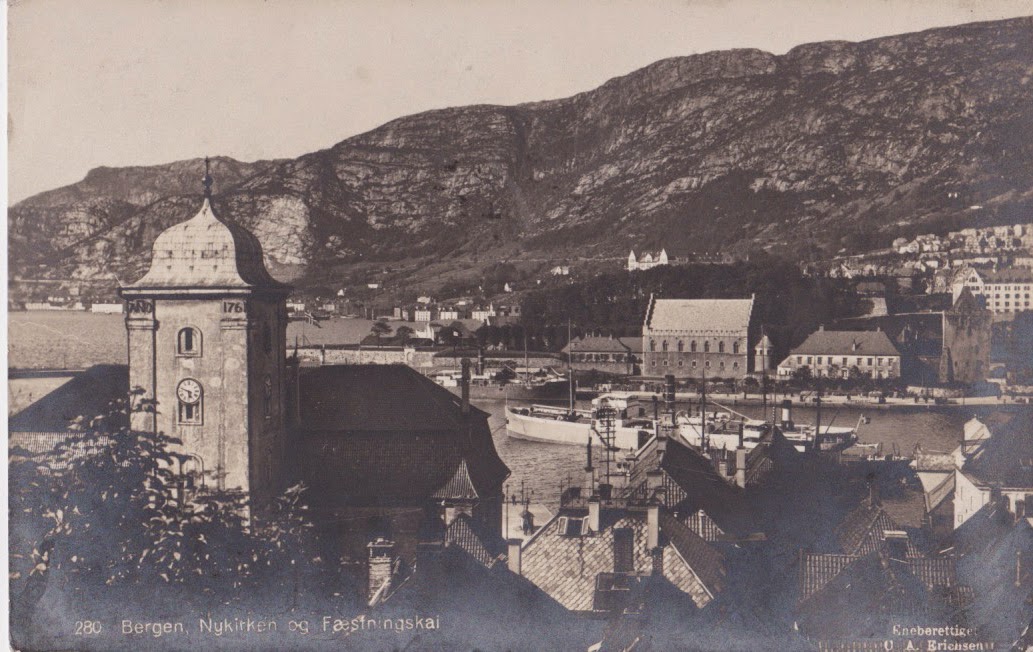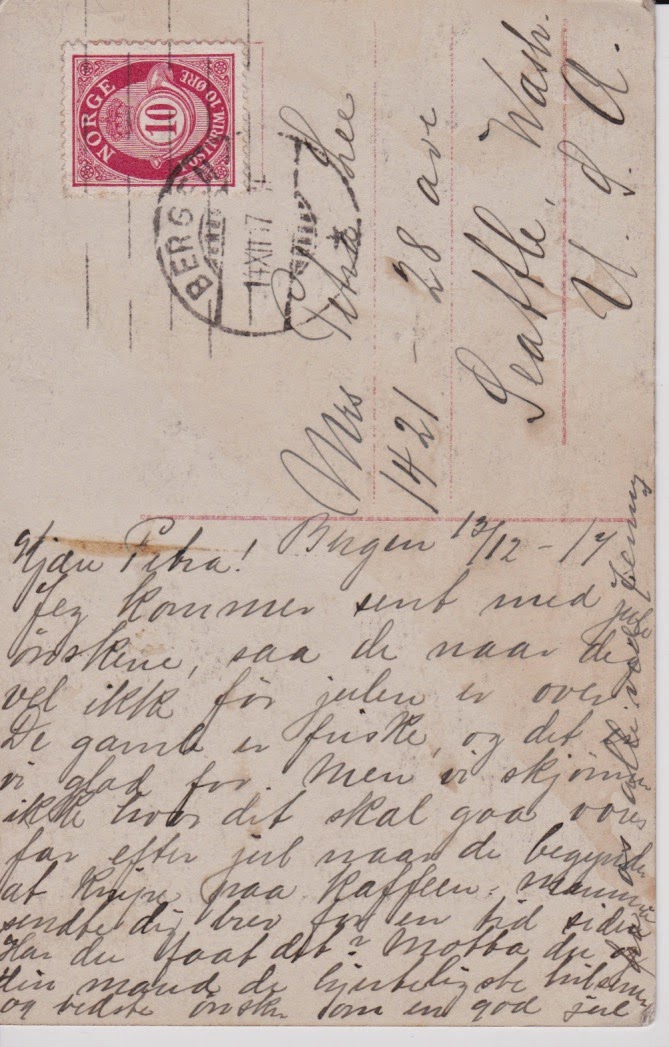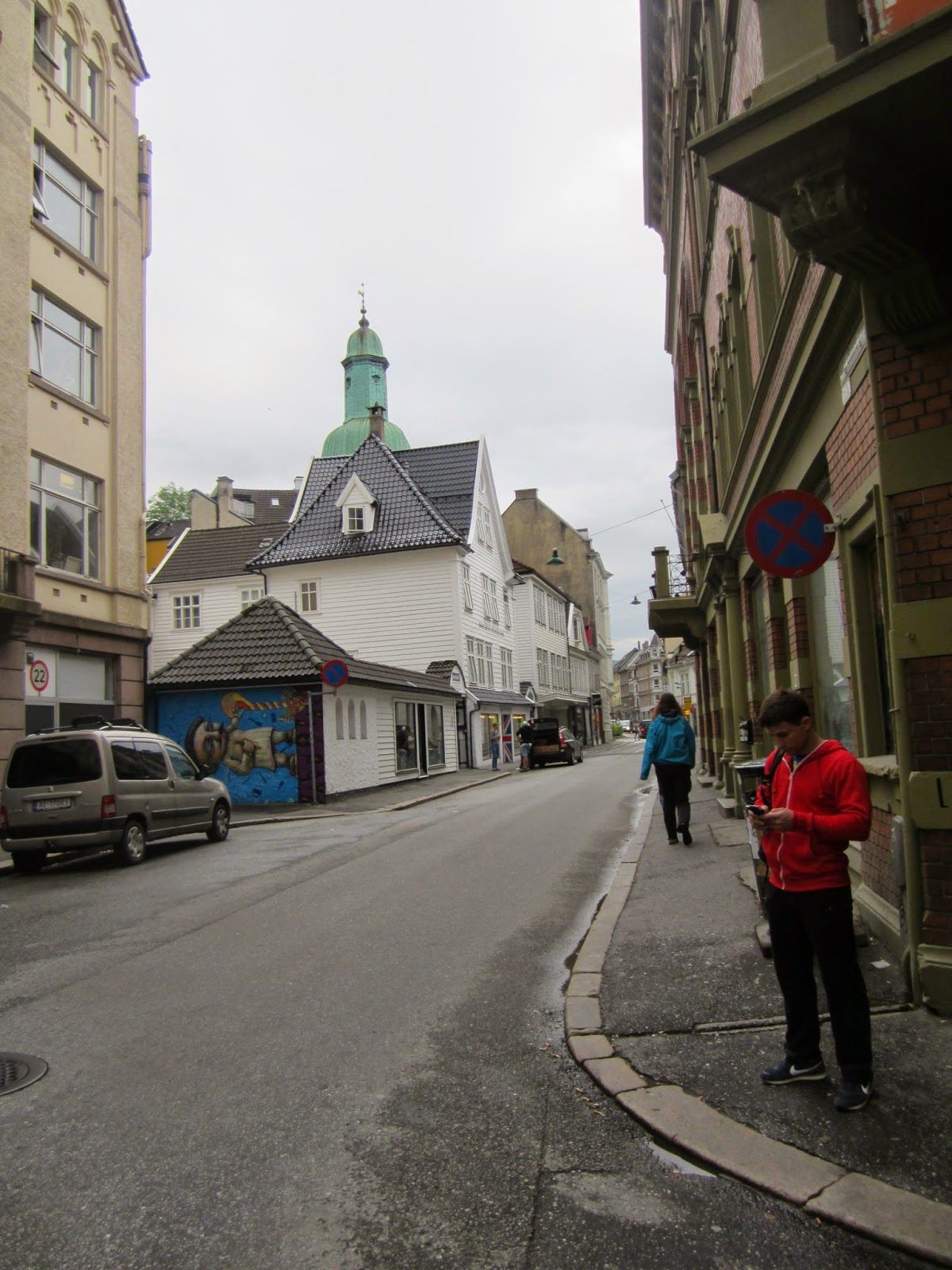Nykirken, Bergen, Norway, 1917
Reverse
Nykirken (the new church) in Bergen, Norway as it looked from 1870 to 1944 is shown on this postcard above sent to Petra Landaas Lee by her friend Jenny in 1917. O.A. Erichsen of Eneberettiget, a postcard company, is credited with the photograph. The black & white photo also shows part of the Bergen harbor. The stamp on this card is a post horn in the amount 10 øre. The card was sent in December and carries Christmas greetings and a short note from Jenny with the promise of a letter to come.
Bergen has many wooden buildings and as a result has had several major fires throughout the centuries that destroyed not only many of the wooden structures but also damaged or destroyed some made of stone. Nykirken was first built in 1621 on the ruins of a stone house that belonged to the archbishop but had burned down in the 14th century. Unfortunately, there was a fire in 1623 that destroyed the church but it was immediately rebuilt. This second church was destroyed by fire in 1660 and again rebuilt in 1670. There were also fires in 1756 and 1800 that required rebuilding efforts.
In 1944 during World War II a German ship exploded in the harbor and left large parts of Bergen in ruins including Nykirken. The reconstruction followed plans from the 1750s including the current spire (much different than the one on the postcard) that had been omitted in 1756. The architect is identified as Johan Joachim Reichborn. Considered Norway’s first skilled architect, Reichborn was born in Hamburg, Germany in 1715 and died in Bergen in 1783. He was responsible for designing and reconstructing many of the buildings in the city that had been destroyed by the 1756 fire. The church today has 750 seats, slightly less than it did before 1944, most are high-sided box pews but there are also some painted wooden benches for children. The picture below from the Bergen archives site and found in Google Images is one of Reichborn’s drawings of Nykirken from 1768.
From Google Images, Bergen Archives, 1768 drawing of Nykirken by J.J. Reichborn
Nykirken is often referred to as the “Children’s Church” and many of the interior decorations are the work of local children. They include hand-painted icons, hanging mobiles and large paintings that have been set in panels to form a stained glass effect at each window. There is also a large carved angel that originally descended from the ceiling by means of a pulley system but is now electrically operated. The angel holds a bowl for infant baptisms and was donated in 1794 but destroyed in 1944. The Bergen Cathedral had a matching angel in storage and that angel has been transferred to Nykirken and is the one in use today.
The current church, built in 1974, and shown in the photo below replaced the church damaged in 1944. I thought the church must be set back from the wharf and docking slips but discovered that it was practically right on the water’s edge. No wonder the explosion in 1944 caused so much damage to it. The harbor is busy and even though it was evening when I took the photo there were still large ships blocking the view of the church. Since we were on foot and the church was across the water from us there was not enough time to walk all the way around to get a better view of it.
Nykirken, Bergen, Norway, 2014
In June of 2014 we took the trip to Norway and Austria that we had planned to take the year before but had to postpone due to a hiking accident that resulted in a broken leg. Bergen was our first stop in Norway after a 10 hour flight from Seattle to Frankfurt, Germany, a 6 hour lay over, and then another 1 hour flight. We were very tired and had tired to take naps on the reclining chairs at the Frankfurt airport but just couldn’t relax because of the airport bustle. We knew we would only have an afternoon and evening in Bergen once we got there and did not want to go to bed too early so we made the decision to keep active, walk around Bergen and see as much as we could in the time available.
When we were planning the trip we decided to use a travel agent and she booked rooms for us on the days we would need a place to stay so we had a room in a nice modest hotel located near the Rosenkrantz tower, wharf, fish market, the funicular rail, a public park and parts of the shopping district. It was a relief not to have to worry about finding somewhere to stay and our agent did a super job reserving nice places at moderate rates close to many different sites within walking distance. This was also our introduction to the fantastic Norwegian breakfast buffet. We soon learned to fill our plates with all the many and varied delicious offerings, a small sample of which is shown here.
Note: My friend, Mary, manages to take pictures of all the wonderful food they have encountered in France and the Czech Republic but I, alas, usually don't think of taking a photo until after I have dined.
Here below are a few more photos from our stay in Bergen.
These colorful buildings above were along the wharf near the hotel and at the beginning of our walk around Bergen.
A small corner of the fish market
A park with a large pool and fountain
I think this is the art museum as it was advertising an exhibit
Statue of the musician and composer Edvard Grieg
Street scenes as we walked. The building seen above caught our attention--it had shoes glued to the walls.
It was getting late but the funicular was still running so we bought a ticket and rode up the mountain to see the view of the city from high above.
We could see the park with the pool and fountain we had visited
The spire of Nykirken is visible at the lower right
The tracks for the funicular--that is a long way down and steep
The gateway into Rosenkrantz tower and courtyard
The tower was built in 1270. It is open to the public but only during certain hours. Our walk took us here just after closing time for interior tours of the tower but we could still enjoy the grounds and looking at things outside. The Nykirken spire could be seen from the courtyard.
Early the next morning we took what my mother used to call a “puddle jumper,” a small prop commuter plane, to the Volda-Ørsta-Hovden airport where we were met by my cousin and her husband who were our hosts for the rest of our stay in Norway. No words can express our gratitude for the many, many kindnesses and hospitality they showed us.
For more about Nykirken, see:
http://www.bergenbyarkiv.no/bergenbyleksikon/arkiv/author/bergenbyleksikon/page/94
http://en.wikipedia.org/wiki/Nykirken
http://www.spottinghistory.com/view/3231/nykirken/
http://no.wikipedia.org/wiki/Johan_Joachim_Reichborn




























No comments:
Post a Comment